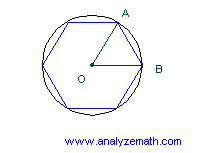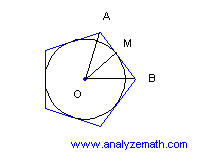Problem 1
A 6 sided regular polygon (hexagon) is inscribed in a circle of radius 10 cm, find the length of one side of the hexagon.
- Angle AOB is given by
angle (AOB) = 360o / 6 = 60o
- Since OA = OB = 10 cm, triangle OAB is isosceles which gives
angle (OAB) = angle (OBA)
- So all three angles of the triangle are equal and therefore it is an equilateral triangle. Hence
AB = OA = OB = 10 cm.
Problem 2
A circle of radius 6 cm is inscribed in a 5 sided regular polygon (pentagon), find the length of one side of the pentagon.(approximate your answer to two decimal places).
Solution to Problem 2:
- Let t be the size of angle AOB, hence
t = 360o / 5 = 72o
- The polygon is regular and OA = OB. Let M be the midpoint of AB so that OM is perpendicular to AB. OM is the radius of the inscribed circle and is equal to 6 cm. Right angle trigonometry gives
tan(t / 2) = MB / OM
- The side of the pentagon is twice MB, hence
side of pentagon = 2 OM tan(t / 2) = 8.7 cm (answer rounded to two decimal places)
Problem 3
Find the area of a dodecagon of side 6 mm. (approximate your answer to one decimal place).Solution to Problem 3:
- A dodecagon is a regular polygon with 12 sides and the central angle t opposite one side of the polygon is given by.
t = 360o / 12 = 30o
- We now use the formula for the area when the side of the regular polygon is known
Area = (1 / 4) n x2 cot (180o / n)
- Set n = 12 and x = 6 mm
area = (1 / 4) (12) (6 mm)2 cot (180o / 12)
= 403.1 mm2 (approximated to 1 decimal place).
Problem 4
Show that if the number of sides n of a polygon inscribed inside a circle of radius R, is very large then the area of the polygon may be approximated by the area of the circumscribed circle with radius R. (HINT: If angle x is very small and is in radians, then sin x may be approximated by x).Solution to Problem 4:
- The area of a regular polygon with n sides may be given in terms of R by
area = (1/2) n R 2 sin (2 pi / n)
- If n is large, then 2 Pi /n is very small and sin (2 pi/n) may be approximated by 2 pi / n so that the area may be approximated by
area = (1/2) n R 2 (2 pi / n)
= pi R 2
- which is the area of the circle.
For more on the above question, see the interactive tutorial in regular polygons.